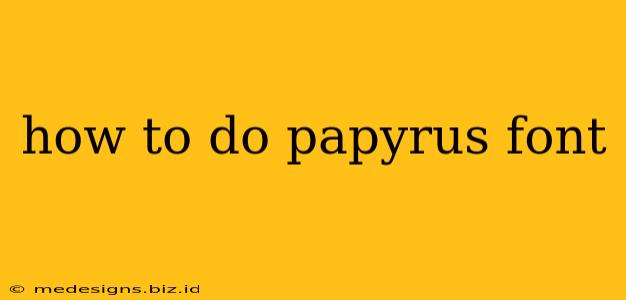Papyrus, that instantly recognizable font, evokes a sense of ancient Egypt and a touch of whimsy. While the font itself has become somewhat of a meme, its distinct qualities—bold strokes, rough edges, and a slightly informal feel—remain appealing for certain projects. This guide explains how to achieve a similar aesthetic, even without using the Papyrus font itself.
Understanding the Papyrus Aesthetic
Before diving into techniques, let's break down what makes Papyrus distinctive:
- Thick Strokes: Papyrus is characterized by its heavy, uneven strokes. These aren't perfectly uniform; they have a handcrafted quality.
- Serif-like Elements: While not true serifs, Papyrus has little flourishes and extensions at the ends of some strokes, giving it a slightly rustic feel.
- Uneven Spacing: The letter spacing and kerning (the space between individual letters) in Papyrus is often quite loose, contributing to its informal appearance.
- Overall Texture: The font suggests a slightly rough, almost textured surface, mimicking the look of hand-drawn or carved lettering.
Methods to Recreate the Papyrus Look
You can achieve a similar aesthetic through several methods, each offering varying degrees of control and effort:
1. Using Similar Fonts
Several fonts share stylistic similarities with Papyrus. Searching for fonts described as "Egyptian," "hieroglyphic," "brush script," or even "rustic" might yield good results. Experiment with different font families; you might find a close enough match to meet your needs without resorting to direct imitation.
2. Hand-Lettering
For a truly authentic feel, hand-lettering is the ultimate method. This approach allows for maximum control and uniqueness. However, it requires artistic skill and time. Start by sketching your text lightly with a pencil, then trace over it with a thicker marker or brush pen to create the bold strokes and varied line weights reminiscent of Papyrus. Consider adding subtle texture with a slightly rough surface or paper.
3. Digital Lettering with Stylus and Tablet
Using a stylus and drawing tablet provides a digital equivalent to hand-lettering. Programs like Adobe Photoshop, Illustrator, or Procreate allow for precise control over strokes, thickness, and texture. You can experiment with different brush tips to mimic the look of ink, paint, or even carved stone.
4. Applying Effects in Graphic Design Software
Even with a standard font, you can manipulate its appearance to resemble Papyrus. In programs like Photoshop or Illustrator, explore techniques such as:
- Stroke Effects: Adding a thick outline to your text can significantly increase the stroke weight.
- Texture Overlays: Applying textures like canvas, paper, or even stone can create the rough, organic feel of Papyrus.
- Distortion Effects: Subtle warping or distortion can introduce irregularities similar to the handmade nature of the original font.
5. Combining Fonts and Techniques
Consider combining several techniques. For example, you could start with a similar font, then add a stroke effect, and finally, layer a subtle texture on top. Experimentation is key!
Choosing the Right Method
The best method depends on your skill level, available tools, and the specific project requirements. If you need a quick and easy solution, exploring similar fonts or applying effects in design software is ideal. If you're aiming for a truly unique and handcrafted look, hand-lettering or digital lettering with a stylus and tablet are the superior choices.
Remember, the key to replicating the Papyrus style isn't about perfectly mimicking the font itself but capturing its overall essence: bold strokes, unevenness, and a sense of handcrafted texture. By experimenting with these techniques, you can create designs that evoke a similar feel, while adding your own personal touch.
